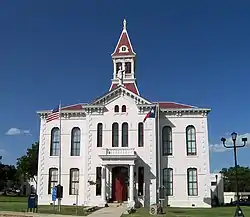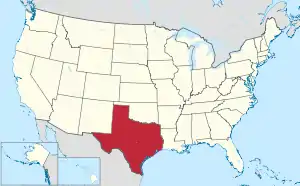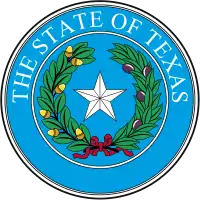Wilson County, Texas
Wilson County is a county located in the U.S. state of Texas. As of the 2010 census, its population was 42,918.[1] Its county seat is Floresville.[2] The county is named after James Charles Wilson.
Wilson County | |
|---|---|
 The Wilson County Courthouse in Floresville. The courthouse was added to the National Register of Historic Places on May 5, 1978. | |
 Location within the U.S. state of Texas | |
 Texas's location within the U.S. | |
| Coordinates: 29°10′N 98°05′W | |
| Country | |
| State | |
| Founded | 1860 |
| Named for | James Charles Wilson |
| Seat | Floresville |
| Largest city | Floresville |
| Area | |
| • Total | 808 sq mi (2,090 km2) |
| • Land | 804 sq mi (2,080 km2) |
| • Water | 4.7 sq mi (12 km2) 0.6% |
| Population (2010) | |
| • Total | 42,918 |
| • Estimate (2018) | 50,224 |
| • Density | 53/sq mi (21/km2) |
| Time zone | UTC−6 (Central) |
| • Summer (DST) | UTC−5 (CDT) |
| Congressional districts | 15th, 28th |
| Website | www |
Wilson County is part of the San Antonio–New Braunfels, Texas, metropolitan statistical area.
History
Native Americans
Archeological evidence in the Wilson County area reveals early habitation from the paleo-Indians hunter-gatherers period.[3][4] Later, the area was a hunting range for Tonkawa, Aranamas, Tamiques, Karankawa. Tawakoni, Lipan Apache, and Comanche lived and hunted in the area.
Explorations and county established
In September 1718 Martín de Alarcón crossed the area on his way to explore the bay of Espíritu Santo. Pedro de Rivera y Villalón crossed the county in 1727 as part of an expedition to inspect the frontier defenses of New Spain.[5] In 1766–67 the Marqués de Rubí included the area in his inspection of the Spanish frontier,[6] and the 1798 explorations of the coast by Francisco Vásquez de Coronado[7] skirted the area.
The first two land grants in the area were to Luis Menchaca and Andrés Hernández,[8] who established ranches circa 1832–1833.
Anglos began arriving in the 1840s,[6] and Southern planters in 1850 and 1860, followed by German and Polish immigrants from other counties.
Wilson County was formed in 1860 from Bexar County and Karnes County. Sutherland Springs[9] was designated the county seat.
Wilson County voted in favor of secession[6] from the Union, and sent several military units to serve. Wartime hardships were compounded by a three-year drought.
Following the civil war, the county seat[10] was moved to Floresville. The 1872 courthouse was destroyed by fire and replaced in 1884 with a new building[11] designed by Alfred Giles.
Fence Cutting Wars in Texas lasted for approximately five years, 1883–1888. The 40,000-acre (160 km2) ranch of Houston and Dilworth became the focal point in Wilson County. As farmers and ranchers began to compete for precious land and water, cattlemen found it more difficult to feed their herds, prompting cowboys to cut through fences. Texas Governor John Ireland[12] prodded a special assembly to order the fence cutters to cease. In response, the legislature made fence-cutting and pasture-burning crimes punishable with prison time, while at the same time regulating fencing. The practice abated with sporadic incidents of related violence 1888.
The San Antonio and Aransas Pass Railway[13] reached Floresville in 1886. In 1898 the San Antonio and Gulf Railroad[14] was extended to Stockdale.
Geography
According to the U.S. Census Bureau, the county has a total area of 808 square miles (2,090 km2), of which 804 square miles (2,080 km2) are land and 4.7 square miles (12 km2) (0.6%) are covered by water.[15]
Major highways
 U.S. Highway 87
U.S. Highway 87 U.S. Highway 181
U.S. Highway 181 State Highway 97
State Highway 97
Adjacent counties
- Guadalupe County (north)
- Gonzales County (northeast)
- Karnes County (southeast)
- Atascosa County (southwest)
- Bexar County (northwest)
Demographics
| Historical population | |||
|---|---|---|---|
| Census | Pop. | %± | |
| 1870 | 2,556 | — | |
| 1880 | 7,118 | 178.5% | |
| 1890 | 10,655 | 49.7% | |
| 1900 | 13,961 | 31.0% | |
| 1910 | 17,066 | 22.2% | |
| 1920 | 17,289 | 1.3% | |
| 1930 | 17,606 | 1.8% | |
| 1940 | 17,066 | −3.1% | |
| 1950 | 14,672 | −14.0% | |
| 1960 | 13,267 | −9.6% | |
| 1970 | 13,041 | −1.7% | |
| 1980 | 16,756 | 28.5% | |
| 1990 | 22,650 | 35.2% | |
| 2000 | 32,408 | 43.1% | |
| 2010 | 42,918 | 32.4% | |
| 2019 (est.) | 51,070 | [16] | 19.0% |
| U.S. Decennial Census[17] 1850–2010[18] 2010–2014[1] | |||
As of the census[19] of 2000, there were 32,408 people, 11,038 households, and 8,830 families residing in the county. The population density was 40 people per square mile (16/km2). There were 12,110 housing units at an average density of 15 per square mile (6/km2). The racial makeup of the county was 81.19% White, 1.21% Black or African American, 0.58% Native American, 0.30% Asian, 0.04% Pacific Islander, 14.25% from other races, and 2.43% from two or more races. 36.52% of the population were Hispanic or Latino of any race.
There were 11,038 households, out of which 40.00% had children under the age of 18 living with them, 66.50% were married couples living together, 9.20% had a female householder with no husband present, and 20.00% were non-families. 17.10% of all households were made up of individuals, and 7.80% had someone living alone who was 65 years of age or older. The average household size was 2.89 and the average family size was 3.26.
In the county, the population was spread out, with 29.20% under the age of 18, 7.60% from 18 to 24, 28.60% from 25 to 44, 23.20% from 45 to 64, and 11.50% who were 65 years of age or older. The median age was 36 years. For every 100 females, there were 99.70 males. For every 100 females age 18 and over, there were 97.00 males.
The median income for a household in the county was $40,006, and the median income for a family was $45,681. Males had a median income of $31,716 versus $23,582 for females. The per capita income for the county was $17,253. About 9.20% of families and 11.30% of the population were below the poverty line, including 12.40% of those under age 18 and 15.80% of those age 65 or over.
Communities
Cities
- Elmendorf (mostly in Bexar County)
- Floresville (county seat)
- La Vernia
- Nixon (mostly in Gonzales County)
- Stockdale
Towns
Unincorporated communities
Ghost towns
- Dewees
- Doseido Colony
- Grass Pond Colony
- Nockenut
- Sandy Hills
Notable people
- John Connally, governor of Texas and U.S. Secretary of the Navy and Treasury
- Merrill Connally, an actor and a county judge
- Wayne Connally, a member of both houses of the Texas State Legislature
- Frank Hamer, Texas Ranger
Gallery
 The "Peanut Marker" at the Wilson County Courthouse lawn commemorates the life of Joe T. Sheehy (1886–1967), who introduced peanut farming to the area in 1916.
The "Peanut Marker" at the Wilson County Courthouse lawn commemorates the life of Joe T. Sheehy (1886–1967), who introduced peanut farming to the area in 1916. The Wilson County Public Library near the courthouse.
The Wilson County Public Library near the courthouse. The Wilson County Hardware store in Floresville.
The Wilson County Hardware store in Floresville.
Politics
Wilson County is a red county in presidential elections. It last voted for a Democrat in 1976, when it supported Georgia's Jimmy Carter. More recently, in 2016, it gave less than a quarter of its vote to Democratic candidate Hillary Clinton. The last time a Democratic candidate won 35% or more of Wilson County's vote was in 1996.
| Year | Republican | Democratic | Third parties |
|---|---|---|---|
| 2020 | 73.8% 18,463 | 25.4% 6,350 | 0.8% 200 |
| 2016 | 72.2% 13,998 | 24.7% 4,790 | 3.1% 607 |
| 2012 | 71.0% 12,218 | 28.0% 4,821 | 1.0% 166 |
| 2008 | 66.6% 10,904 | 32.8% 5,362 | 0.6% 100 |
| 2004 | 69.9% 10,400 | 29.6% 4,409 | 0.5% 76 |
| 2000 | 64.2% 7,509 | 34.2% 3,997 | 1.6% 192 |
| 1996 | 50.0% 4,530 | 41.0% 3,713 | 9.1% 824 |
| 1992 | 39.1% 3,766 | 38.6% 3,711 | 22.3% 2,148 |
| 1988 | 52.7% 4,436 | 46.9% 3,953 | 0.4% 36 |
| 1984 | 61.7% 4,588 | 38.1% 2,829 | 0.2% 17 |
| 1980 | 51.9% 3,443 | 46.7% 3,097 | 1.4% 92 |
| 1976 | 32.6% 1,926 | 67.3% 3,973 | 0.1% 3 |
| 1972 | 58.7% 2,953 | 41.2% 2,072 | 0.1% 7 |
| 1968 | 31.5% 1,321 | 55.6% 2,336 | 12.9% 542 |
| 1964 | 17.1% 718 | 82.8% 3,472 | 0.1% 5 |
| 1960 | 30.0% 1,248 | 69.9% 2,905 | 0.1% 4 |
| 1956 | 41.3% 1,519 | 58.4% 2,149 | 0.3% 10 |
| 1952 | 45.4% 1,823 | 54.5% 2,187 | 0.1% 5 |
| 1948 | 19.6% 593 | 76.6% 2,313 | 3.8% 114 |
| 1944 | 19.1% 676 | 75.5% 2,666 | 5.4% 191 |
| 1940 | 18.0% 605 | 81.9% 2,750 | 0.1% 4 |
| 1936 | 10.0% 286 | 89.8% 2,573 | 0.2% 5 |
| 1932 | 6.7% 174 | 93.2% 2,435 | 0.1% 3 |
| 1928 | 29.3% 622 | 70.7% 1,499 | |
| 1924 | 20.2% 495 | 66.5% 1,633 | 13.3% 326 |
| 1920 | 46.1% 820 | 42.3% 753 | 11.6% 206 |
| 1916 | 27.6% 346 | 69.4% 869 | 3.0% 37 |
| 1912 | 9.2% 95 | 75.2% 778 | 15.7% 162 |
See also
References
- "State & County QuickFacts". United States Census Bureau. Archived from the original on December 31, 2015. Retrieved December 29, 2013.
- "Find a County". National Association of Counties. Retrieved 2011-06-07.
- "Native Peoples of the South Texas Plains During Early Historic Times". Texas Beyond History. Retrieved 13 May 2010. UT Texas at Austin
- "Artistic Expression". Texas Beyond History. Retrieved 13 May 2010. UT Texas at Austin
- Blake, Robert Bruce: Pedro de Rivera y Villalón from the Handbook of Texas Online. Retrieved 13 May 2010. Texas State Historical Association
- Long, Christopher: Wilson County from the Handbook of Texas Online. Retrieved 13 May 2010. Texas State Historical Association
- Flint, Richard; Flint, Shirley Cushing (2004). The Coronado Expedition to Tierra Nueva: The 1540–1542 Route Across the Southwest. University Press of Colorado. ISBN 978-0-87081-766-3.
- "Menchaca-Hernández Compromise" (PDF). Texas General Land Office. Retrieved 13 May 2010. Texas General Land Office
- "Sutherland Springs, Texas". Texas Escapes - Blueprints For Travel, LLC. Retrieved 13 May 2010. Texas Escapes - Blueprints For Travel, LLC.
- "Floresville, Texas". Texas Escapes - Blueprints For Travel, LLC. Retrieved 13 May 2010. Texas Escapes - Blueprints For Travel, LLC.
- "Wilson County Courthouse". Texas Escapes - Blueprints For Travel, LLC. Retrieved 13 May 2010. Texas Escapes - Blueprints For Travel, LLC.
- "Fence Cutting Wars, Texas Adjutant General R.N. Steagal Letter To John Ireland March 31, 1884". Texas State Library and Archives Commission. Retrieved 13 May 2010. Texas State Library and Archives Commission
- "San Antonio and Aransas Pass Railway". Archived from the original on 12 September 2006. Retrieved 13 May 2010.
- Williams, Howard C: Texas and New Orleans Railroad from the Handbook of Texas Online. Retrieved 13 May 2010. Texas State Historical Association
- "2010 Census Gazetteer Files". United States Census Bureau. August 22, 2012. Retrieved May 12, 2015.
- "Population and Housing Unit Estimates". United States Census Bureau. May 24, 2020. Retrieved May 27, 2020.
- "U.S. Decennial Census". United States Census Bureau. Retrieved May 12, 2015.
- "Texas Almanac: Population History of Counties from 1850–2010" (PDF). Texas Almanac. Retrieved May 12, 2015.
- "U.S. Census website". United States Census Bureau. Retrieved 2011-05-14.
- Leip, David. "Dave Leip's Atlas of U.S. Presidential Elections". uselectionatlas.org. Retrieved 5 November 2017.
